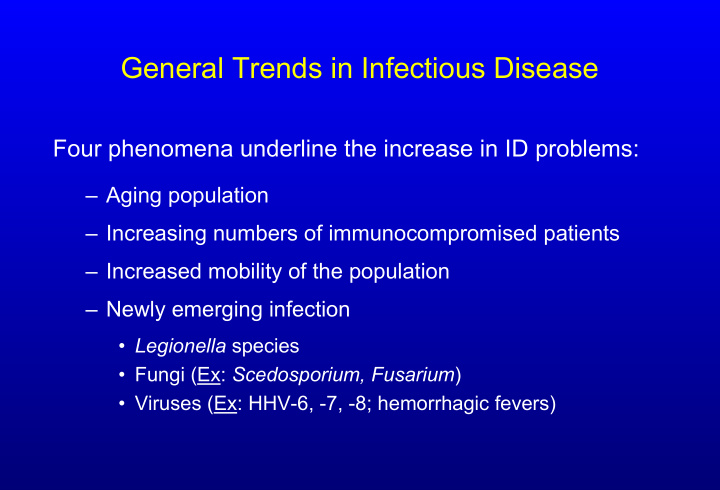



General Trends in Infectious Disease Four phenomena underline the increase in ID problems: – Aging population – Increasing numbers of immunocompromised patients – Increased mobility of the population – Newly emerging infection • Legionella species • Fungi (Ex: Scedosporium, Fusarium ) • Viruses (Ex: HHV-6, -7, -8; hemorrhagic fevers)
AIDS and Other Infections Paradigm: Tuberculosis – AIDS promotes the spread of tuberculosis – Because of the impaired inflammatory response, disease further advanced, with higher microbial burden at time of discovery. Facilitates spread from person-to-person – Confluence of two processes in the same population (inner city minorities and developing countries) • Drug-resistant TB • HIV infection – End result: Potential disaster – Solution: Case finding and surveillance; directly observed therapy
Normal host Symptom Severity Immunocompromised host Time
Microbial load Normal host Time
Drug Resistance • Bacteria produce enzymes that either destroy the antibiotic (beta- lactamases) or add bulky groups to structure, presenting penetration of bacterial cell wall (Ex: aminoglycosides) • Alteration of target molecules – Penicillin binding proteins – Folic acid synthetic enzymes • Change in porins that permit antimicrobial entry into bacterial cells • Acquisition or expression of pumps that rid the cell of the antimicrobial drugs
Problem Organisms • Multi drug-resistant Mycobacterium tuberculosis • Beta-lactamase producing bacteria – Staphylococcus aureus – Gram negatives, particularly beta lactamase hyper-producing gram negative bacilli (e.g., Serratia, Enterobacter, etc.) • Vancomycin-resistant enterococci – Vancomycin intermediate resistance in S. Aureus • Penicillin-resistant Streptococcus pneumoniae • Azole-resistant yeast
Special Problems of the Enterococci • Naturally tolerant (bacteriostatic effect) – Conventional treatment: penicillin + gentamicin = synergistic killing (bactericidal effect) • High level gentamicin resistance (= no bactericidal effect) • Beta lactamase production--need vancomycin • Vancomycin-resistant enterococci (change in penicillin binding proteins) • Enterococci are “wimp organisms”. Big worry is if Staphylococcus aureus , a virulent species, becomes vancomycin resistant (as of today, only intermediately resistant Staphylococcus aureus )
What Has Been Done to Meet These Challenges? • A dearth of new structures that are effective antimicrobial agents – Virtually all new antimicrobials represent old structures with new medicinal chemistry. • Minimal efforts for new vaccines – Liability issues and tort law • Need new technology for both discovery and development
Clinical Conditions Which Require Bactericidal Therapy • Severe neutropenia • Central Nervous System infection • Staphylococcal (and presumably other forms) of osteomyelitis • Cardiovascular infection • Prosthesis-associated infections – Hip, knee, and other joint prostheses – Vascular access devices – Foreign body associated infection
The Second Law of Thermodynamics According to an Infectious Disease Practitioner •The world is constantly heading towards chaos and disaster. – The Post-antimicrobial Era (antimicrobial resistance) – Bio-terrorism – Newly Emerging Infections
•1969 - Lhassa Fever – index illness: a native nurse who had cared for a local person with a similar illness, dying with: • Encephalitis (seizures, focal neurologic disease) • Hepatic necrosis • DIC – SPREAD: • American nurse → 5 caretakers at Presbyterian Hospital
The Paradigm of Patient Care Algorithms vs. Anomalies
“. . . It is time to close the book on infectious diseases. The war against pestilence is over.” William Stewart, Surgeon General in a message to Congress, 1969
“ Our heads are round so that our thinking can change direction.” - Francis Picaba
“No medicine in the world can do thee good ….” Laertes to Hamlet Hamlet, Act V, Scene 2 W. Shakespeare
Recommend
More recommend